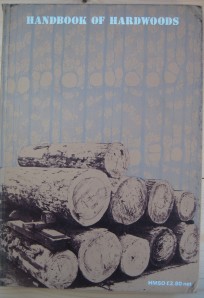 Here is a problem that often confronts me as a book volunteer.
Here is a problem that often confronts me as a book volunteer.
I open a box in the Oxfam sorting room to find an old reference book, with no pictures. It used to belong to a library so has disfiguring marks at the front, worn corners and a plasticky feel. Would any of our discerning customers look at it twice? Is it worth putting into the shop?
But I make the mistake of opening it up, finding it interesting and spending too long reading it in the sorting room, arguing, first with myself and then with other volunteers for its space on the shelves. And then I have to will it to be bought….to raise money for Oxfam (obviously) but (shamefully) for my judgement to be proved right.
This ‘Handbook of Hardwoods’ is full of fascinating facts that you wouldn’t look up on the internet because most probably you wouldn’t know that these facts were available, just waiting to be known: “an unknown unknown” as Donald Rumsfeld would put it.
So, here’s a quiz on hardwoods as described in this book.
Which of the following hardwoods Poplar/Ebony/Cedar/Sweet Chestnut/Boxwood/Balsa/Oak/Willow/Teak/Ash/Hornbeam/Elm is used to make:
- Skittles, croquet mallets, chessmen and shuttles in the silk industry
- Ornamental bowls and kitchen utensils, walking sticks, umbrella handles and casks for oils and fats
- Matches
- Musical instruments, especially pianos, clavichords and harpsichords. Also drum sticks and billiard cues
- Coffins and the bottoms of canal boats
- Hockey sticks, baseball bats, cricket stumps, tool handles
- Insulating material, packaging
- Church furniture and mining timber
- Ship decking, rails and hatches
- Cigar boxes and sounding boards for organs
- Cricket bats and artificial limbs
- Tool handles, door knobs, violin finger boards and pegs, piano and organ keys.
(Answers: below)
All these facts are here along with a description of the tree, information on how the wood dries, what it’s like to work with, its durability, its colour, strength and suitability for bending or processing as plywood and more.
Even if your only interest in timber is knowing which is best for your wood burning stove, this book deserves a place on your shelves.
Handbook of Hardwoods, published by HMSO in 1972, is on sale at Oxfam Wilmslow for £2.99. It won’t linger on the shelves – promise!

